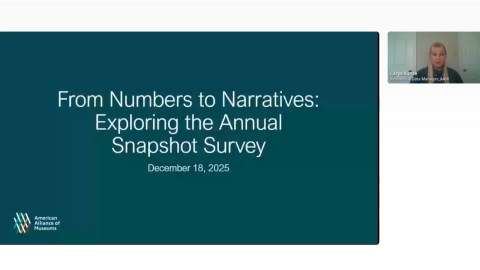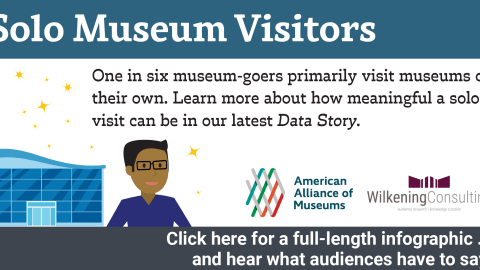
Last September, AAM released Museums and Trust 2021, a survey that measured how museums were performing during a time of record public distrust in a wide range of institutions, from news outlets to the government. As with any good research, these results raised as many questions as they answered, and we invited readers to contribute their own thoughts on the subject of trust. James Gardner took a critical look at the nature of public trust, and what the public thinks museums do. Today on the blog, John Voiklis and John Fraser examine the trust data in the context of their own work at the nonprofit research institution Knology.
–Elizabeth Merritt, VP Strategic Foresight and Founding Director, Center for the Future of Museums
The headline from AAM’s Museums and Trust, Spring 2021 report is that museums “remain trustworthy.” However, as researchers who study museums and trust, we argue that this is impossible, because trust in museums is not a thing. Trustworthiness is a quality ascribed to a particular entity, on whom the individual depends for a particular outcome. This is not something you can apply to a generic concept of a museum.
When we ask people questions about museums in general, they tend to anchor back to some accessible memory of a specific museum. They may assume we are asking about an art museum, or their favorite history center, or their local historical society, or the zoo where their friend volunteers. Even if we ask them about a particular type of museum, they likely think about a stereotype of that type that does not capture the variation within it. Even more narrowly, if we ask people about the very particular museum they might be visiting at the moment, we cannot discount the roles of etiquette, social desirability, and/or cognitive dissonance reduction in how they respond. It would be polite for them to say that they trust the museum they are visiting (etiquette), it would be a way to emulate normative values (social desirability), and it would be consistent with their choice to spend time and treasure on the visit (cognitive dissonance reduction).
These biases obtain even when we ask people to compare institutions. For example, in one of our trust studies, we used our so-called Lake Wobegon Scale to assess whether visitors extend the Lake Wobegon Effect (a.k.a. the illusory superiority bias) to places they are visiting. We presented visitors at nearly one hundred zoos or aquariums with several behaviors the public reliably associates with trustworthy institutions, e.g., “provides animals with proper medical care” and “helps conserve species in the wild.” For each behavior, we asked the visitors to compare the performance of the institution they were visiting to other zoos and aquariums: did it perform better, worse, or about the same? As expected, the results showed that they tended to judge the zoos and aquariums they were visiting as above average.
Despite these biases and conceptual difficulties, museum professionals are always eager to know whether the public sees their field in general as trustworthy. Museums and Trust, Spring 2021 attempts to answer this question by comparing the reported trustworthiness of museums to other entities in public life, such as the local press and the US government. This approach, while potentially insightful, does not fully elucidate public trust in museums trust, because no one appears to have asked the question James Gardner aptly asks in an earlier blog about the report: What does it mean to be trustworthy? One of the takeaways from the report, for instance, is that people trust museums about as much as they trust their family and friends. But what could that possibly mean? Certainly, people do not trust museums for the same reasons they trust their family and friends. People trust their accountants with their taxes, but they do not ask them for medical advice. Trust is a function of the entity (whether person or institution) and the task people need that entity to fulfill.
At Knology, we’ve been studying trust in museums for the past fifteen years, often in partnership with the Association of Zoos and Aquariums (AZA). In that time, we have observed and worked to overcome the murkiness of the concepts involved in assessing institutional trust (what is trust and what does it mean to trust a museum?) and the respondent biases that often appear in the process. Ultimately, this has led us to take a behavioral approach to assessing how people confer trust on institutions, rather than asking them outright. For instance, in a recent series of NSF-funded studies, we asked respondents to judge up to one hundred behaviors that are common to zoos and aquariums (as validated by the AZA and previous research). In their responses, we found that people answered our questions as if they were answering five more basic questions: Are zoos and aquariums…
- Competent?
- Reliable?
- Sincere?
- Benevolent?
- Principled?
In research and theory on trust, these underlying questions show up repeatedly, which suggests that judging the “trustworthiness” of an entity involves at least five different judgements. This appears equally true whether you are deciding if you should trust a person such as a barber, a machine such as a self-driving car, or an institution such as the for-profit Museum of Ice Cream.
Trustworthiness in the Museums and Trust report had a much narrower scope. As Gardner points out in his blog post, the top reasons that survey participants said they trusted museums indicate only that they think these institutions are competent in the job they do—presenting researched “facts” about the “authentic” objects they collect and exhibit. We agree with Gardner that museums should not take comfort in “a trust that is based only on the authenticity of our objects and the authority of our institutions.” The remaining reasons in the report touch on principles of objectivity, the contentious issue of a purported desire for “nonpartisan neutrality,” and disinterest. Gardner argues that these reasons reveal a misconception (on the part of the public; perhaps a misrepresentation on the part of museums) about the many choices and points of view that go into curating museum collections and exhibits. We again agree with Gardner that museums need to be transparent (i.e., sincere) about the job they do. If they were open about their choices and points of view, then they would encourage audiences to engage with (and perhaps contest) those points of view. What they might lose in shedding their seeming neutrality, they would gain in an observable commitment to the principle of pluralism.
This is, perhaps, where Gardner was going when he said that “issues of trust are wrapped up in demographics.” Many of our museums must contend with histories of racism, exclusion, and tacit behaviors that offend entire classes of people. Transparency and engagement might not suffice to reverse and repair that damage. Simply adding other voices to the dominant white, male, heteronormative narrative does not validate the experiences of diverse publics or address historical exclusions. We would add that museums need to demonstrate benevolence: they need to show that they care about people’s lives. In our study of zoos and aquariums, benevolence included behaviors related to the caring treatment of animals, the visitors, and the people who work or volunteer at the institutions. Benevolence was the one place where respondents believed the performance of zoos and aquariums needed improvement. For all other judgments—competence, reliability, etc.—their performance met expectations.
Do museums, in general, show that they care about people? Market research shows that people who have given up on visiting museums cite reasons such as feeling unwelcome and being treated badly in the past. Even museum members—the people most devoted to the institutions—have persistent complaints about poor treatment. The fact that rude staff ranks as the foremost reason for visitor dissatisfaction seems telling: a rude staff may signal disgruntled employees. Taken together, these data points do not speak in favor of museums showing they care about people. If, in fact, museums do care about people (actual and potential visitors, as well as staff and volunteers), then they need to show it in more obvious ways. We hope that recent attention to diversity, equity, accessibility, and inclusion will guide museums, especially their human resources and visitor services departments, in a more benevolent direction. Showing benevolence to the larger audience of visitors and non-visitors (potential, former, and seemingly uninterested) will likely require attention to people’s needs, motives, and values.
What are people’s needs, motives, and values? At Knology, we are beginning to explore that question, starting with an NSF-funded conference where social science theorists and STEM museum professionals are exploring how to speak to people’s social-moral motives (to help and/or protect themselves, those nearest them, and society at large) when communicating STEM information. One of the goals of the conference is to develop a research agenda, but until then we can speculate based on what we know about the motivations of people working in the helping professions (e.g., healthcare). For many of these people, what first sparked their interest in STEM learning was the desire to help and/or protect a loved one. The same motive may hold true for visitors to STEM-related museums, and even to other types of museums. Thus, one way museums can convey their benevolence is by speaking to people’s desire to improve their own lives and the lives of those around them. This approach to conveying benevolence may also open the door to excluded communities, among whom community-minded action is often a value.
In terms of values, we have telling results from our study about zoos and aquariums. All Americans require that zoos and aquariums demonstrate benevolence and transparency (i.e., sincerity) as fundamental attributes of trust. But among the other three attributes, some matter more to certain subgroups of people. For example, people who value environmental conservation are less concerned about the quality of the zoo’s visitor experience, whereas people who visit zoos for personal experience care more about it. Nuances like these wash out when we look only at aggregated data, or when we disaggregate the data only by established demographic categories, concealing the unifying values that cut across those categories.
So, as Gardner points out, the truth about museums and trust is not as simple as the headline that museums “remain trustworthy.” We do not believe that any museum has the capacity to simply “remain trustworthy,” but must actively and constantly cultivate trust in the hearts and minds of the public by offering them actionable recommendations. We also believe that the time is right for us to explore how museum practice and history has created the risk of reinforcing majority views that exclude classes of people. It is these risk propositions that require us to consider trust in museums as a bank account that we will squander if we do not work to reshape the field and redress past and ongoing wrongs. While people may express high trust when they are visiting a museum, that trust is fragile and easily lost once the visit is over, or sometimes even before. Once lost, it is much harder to regain.








This is a classic example of studying a subject enough until you find the answer that you always wanted. At least by the accounts of many critics, museums in the US are presently going through a paroxysm of self-doubt. Assuming this is the case, it would make the most sense to do piercing studies of the internal audience for museums, rather than the external audience. Long-term surveys of the external audience have shown that even segments of the population that don’t typically visit museums, or don’t particularly like museums, feel fairly confident that museums are of benefit to society at large. Nevertheless, it appears many people who presently work in museums – or those who would wish to work in museums – are dissatisfied with aspects of those organizations. Just how these issues of dissatisfaction – and distrust – can be resolved remains to be determined.